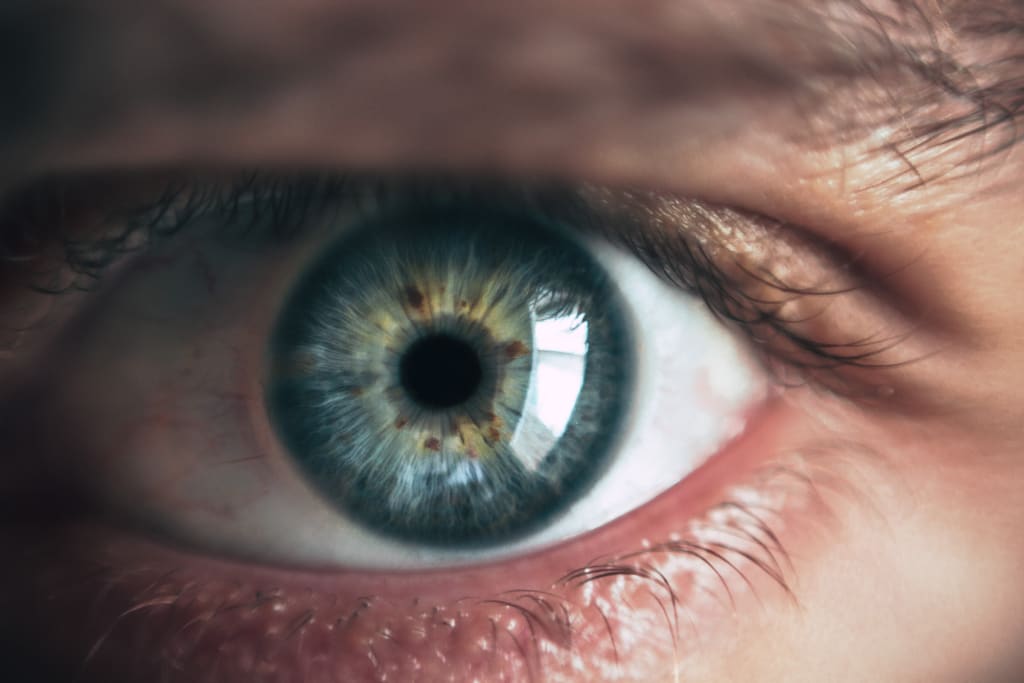Living With Hemianopia.
Every day you are being confronted with your Hemianopia.

Hemianopia.
Hemianopsia, or hemianopia, is a loss of vision or blindness (anopsia) in half the visual field, usually on one side of the vertical midline. The most common causes of this damage are stroke, brain tumor, and trauma.
(Source: Wikipedia)
It took me quite some time before I heard the correct word for what I had. Of course, people tell you what you have, but it was difficult to catch it. But what does it have to do with me?
January 1 and January 16, 2013. On both dates, I was struck by a hemorrhage. You can read more about it in “A Bacteria Changed My Life”. The result of this hemorrhage was, that I was left with Hemianopia. It was a strange sensation/perception/feeling/emotion. It is not easy to describe what you have, feel, or see.
How.
How can you explain this to others when you yourself have no idea what is going on. For me, (after my hemorrhage) I noticed that there was something wrong when I started to look or focus on people. When I looked at a nurse or doctor, while I was in the hospital, and tried to look at them at their face, I only saw a half face. I only saw the left half.
The first time I was confused/puzzled. You start wondering what is wrong or what is wrong with your eyes. “Was it like this before? Did I miss something? Was it always like this?”
Normally I wear glasses but just after the hemorrhage, I did not wear them for a few days. I did not feel like it. So my first thoughts were that it could be because of that. But after putting on my glasses, there was no difference. Also when I looked at the name of the medication I was given, I had trouble reading it. For example, the word Paracetamol. For me, I only saw Para. Only when I read further down the line, then I slowly saw the letters appearing.
Your mind goes a little bit crazy. Because normally if you look at a word, you can see it in one go. And now you only see the first few letters and the rest slowly follow when you go further to the right.
Half view.
To make it clear, my hemianopia is on the right side of my field of vision. So on the right side of my field of vision, my view is limited. In many examples you can find all over the internet, it is mainly the full right side that’s missing. So you only see half of the picture/image. But that is a bit of black and white.
There is not a middle line. It is just there or not. Your mind does not really register. There is a very simple example/illustration of it.
Look straight ahead.
Close your right eye.
You notice that a part of your field of vision disappears. But your brain just tells you it is not there. You also don’t see a black field or space. It is just not there. And in this case, you are just closing one eye. But for my hemianopia, it is in both eyes. And in both eyes, the right side is just not there.
Limited Information.
When I told the nurses what I was experiencing, they already tried to tell me what it was. But of course, it had just happened and your mind is not ready yet to accept or catch what they are saying.
Once I was home again and learned what it was that I had, I started to search the internet to find information about it. But it was very limited and still difficult to understand or grasp the full notion about it. Only when I was going for therapy for it, it was slowly explained to me and slowly I started to understand it a little bit.
But nowadays, if you search for it, you can find a lot of information/videos/images about it. For example, I found a video on Youtube, and it shows what it is or what people with hemianopia see. It is simply called “Hemianopia”. It starts by trying to explain how the eyes and brains work and later on it is showing some examples of what people see.
I will try to give some personal experience/examples, or a short explanation, using some time stamps.
0:00–3:19
In the first part of the video, it is all theory about how the eye works and what it is in the brain. For people with and normal field of vision and with Hemianopia.
3:19–4:30
In this part of the time stamp, they explain a little bit about an eye-tracking system they use and explain a little bit about what people see or don’t see.
4:30–5:05
Reading. First, it is shown, how “normal” people read.
5:05–5:29
Reading, with simulated right hemianopia.
5:29–6:47
Still reading, but as you read, you are more focused on a small part of what you are reading. You can see, that things slow down and that it is not easy to read. This is the same in my case. When they switch to simulate left side hemianopia, the reading is a little bit faster. Because they can see the words/letters that are still coming.
6:47–8:28
Moving images with simulated right hemianopia. As it is mentioned in the video, it is tiring to watch a football match or something else that is fast-moving. Every time you are losing the object you are following. And every time you are searching for it. Especially if you are watching something with subtitles. You are focusing on trying to read, but before you can read the whole sentence or subtitle, it is already gone and you miss parts of it. I prefer to watch things on tv, in which I understand the language and don’t need to read the subtitles. Then, to watch something and I need to read the subtitles and miss half of what they are saying. Also if things are happening on the right side of the screen, I simply miss it and sometimes have no idea what had happened.
8:28–9:00
They give a small tip about what people with right hemianopia can do when watching tv. But they also tell clearly, what the disadvantage is of that tip.
In the video, they show how it is. But every time it is a 50% hemianopia on the right or left side. In my case, I am missing something like 30–40% of the vision field. It is a little bit from what they are showing, but that doesn’t make things easier.
Getting Used To It.
I hope the video had given you a better idea of what people with hemianopia are experiencing.
I have hemianopia since January 2013 but still, I am not used to it. Okay, I had to get some therapy/training and courses on how to use certain things. Or how to adapt to it. But it is not easy. Now and then, you forget what you have. And you will then be confronted again with it.
There is one personal example. I was walking outside and wanted to cross the road. I looked to the far left and saw that a car was still far enough away for me to cross the road. At the moment that I wanted to take a step forward, I suddenly heard a car. Again I quickly looked to the left and saw a car, nearby. I got a shock. I completely missed that car. When I had looked to the left, that car was in my “blind spot”. The missing part of my vision.
When something like that happens, you are shocked. And maybe upset. You are blaming yourself for not paying closer attention to your surroundings. Sometimes you just forget small things like that.
Around that time, I had that therapy. They also teach you to scan your surroundings differently. It is a bit of compensating for what you “cannot see”. This therapy was given by “Bartimeus”. The same organization that also made the video. This therapy helped me a lot.
The same with reading. You can have your good days and bad days. Sometimes when I read, things go okay. Other times, I sometimes need to read a sentence several times before it is making sense. Just because I am missing words. And sometimes I am stuck on a long difficult word and trying to puzzle the letters together in my mind, to form the whole word. And not understanding what the word is and reading it again and again before it makes sense.
Also, normally when you look at a page full of text, for "normal" people it is easy to scan a page. It is easy to find the words or numbers you are looking for. They can see the whole page in one go. For me, I cannot scan a page like that. I need to look it over line by line. So it is not easy or quick to find a certain word or number. I could scan a page, but I would miss half of it.
For reading books, in the beginning, I just used audiobooks. Easy. But not everything you want to read is available in audio form. So slowly on, you are still going back to normal books. Okay, now on tablets or computers, you have the option that your tablet or computer read to you the text you selected. But for some reason, I cannot get used to it. Over time, I have very slowly accepted it and still prefer to read myself.
Closing.
Living with hemianopia is not easy. It takes time to accept it and to get used to it. But you will never get fully used to it. Now and then things happen, that you did not see it coming.
Almost every day, you are confronted with your limitation. The thing is, that you need to learn to live with it. If something happens, you need to accept it and move on. It is not good the dwell on it. I know, it is easier said than done. But with time, you will learn to accept it.
For myself, I did not sit down in a corner and felt pitty with myself. I tried to pick up my “normal” life as much as possible. I take things slow. And to be honest, I am trying to avoid reading out loud. Reading out loud is not easy and I will stutter a lot. Just reading in my mind, to myself, is okay. Not fast but I am okay with it.
Maybe one way that also helped me a bit, is writing about it. Maybe it is a strange combination. Having problems reading and still writing. I must confess, I use the spell checker and Grammarly a lot.
Hemianopia can be tiring, frustrating, and at some times demotivating. But it is a part of my life. It also has helped me a lot, that I have people around me that are understanding and have patience. And I hope that with this, I had given everyone a small view of my daily “struggle”.
For now, please take care and stay safe.
God Bless.
About the Creator
Pierre de Man
Husband, Father, Heart Patient, Christian, Blogger on pierredeman.nl. Through writing I can process what is going on in my life and get it out of my system.






Comments
There are no comments for this story
Be the first to respond and start the conversation.